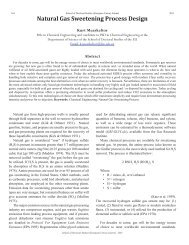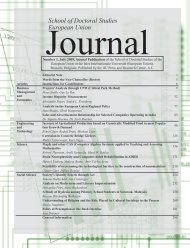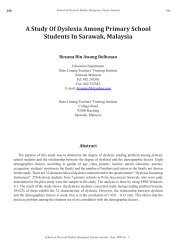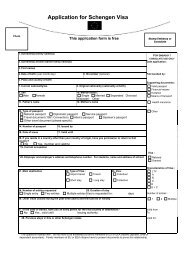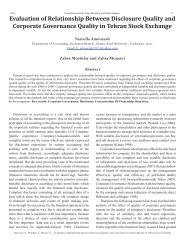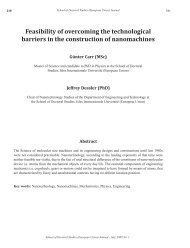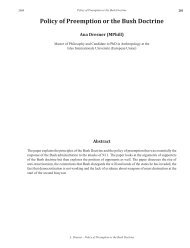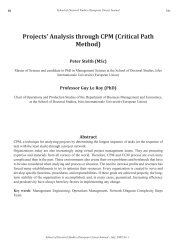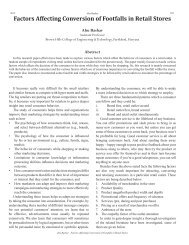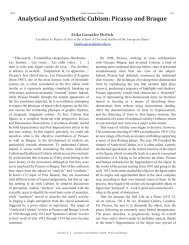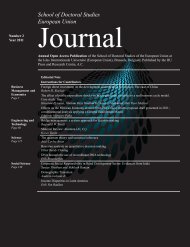Iiuedu.eu
Iiuedu.eu
Iiuedu.eu
You also want an ePaper? Increase the reach of your titles
YUMPU automatically turns print PDFs into web optimized ePapers that Google loves.
36 School of Doctoral Studies (European Union) Journal2011assurance and empathy have significant values and thus,significantly contributed to the explanation of the dependentvariable. To this end, hypotheses H1, H2, H3 and H4 aresupported and hypothesis H5, rejected. Overall, this studyconcluded that mobile service provider service qualityelements affects client loyalty by explaining 48 percent ofthe variance in the Dependent Variable (loyalty) which isquite respectable considering the nature of the research –consumer behaviour.Table I: Regression results of Service Quality and CustomerLoyalty of mobile service providerModelUnstandardizedCoefficientsStd.BErrorStandardizedCoefficientBetatSig.1 Constant} 0.482 0.320 1.507 0.133Tangibility 0.398 0.062 0.365 6.394 0.000Reliability 0.103 0.089 0.074 1.154 0.249Responsiveness 0.035 0.101 0.024 0.346 0.730Assurance 0.519 0.089 0.376 5.866 0.000Empathy -0.147 0.055 -0.131 -2.673 0.008Dependent variable: customer loyalty R² 0.486Adjusted R² 0.478Customer Satisfaction and Customer LoyaltyTable II shows the regression results indicating therelationship between client satisfaction and client loyalty.The R 2 value of 0.711 indicates that over seventy percent ofclient satisfaction is associated with client loyalty. Meaningthat over 70% of the variance in the dependant variable(loyalty) is accounted for by customer satisfaction. In otherwords the positive significant coefficient suggests higherclient satisfaction on mobile service provider results intohigher level of client loyalty to the mobile provider. To thisend therefore, hypothesis H6 is equally supported.Discussion and ConclusionThe study found that the customer satisfaction playsan important role to enhance the level of customer loyalty.This means the higher the level of customer satisfactionthe more loyal the customer of mobile phone becomeand the reverse is the case. This result is consistent withthe findings of Cronin & Taylor (1992). The implicationfor the management of mobile phone service providers isthat they should strive to ensure high level of customersatisfaction which will eventually leads to customer loyalty.Ensuring customer satisfaction could perhaps be achievedby identifying, focusing and improving the factors thatclients consider in determining their level of satisfactionwith a particular mobile service provider. The fact that thisis beyond the scope of this study, we hereby recommendthat future research investigate the factors determiningcustomer satisfaction for a particular mobile service.Furthermore, the findings also indicate that servicequality has influence on customer loyalty with regards tothe service delivery of mobile service providers. In fact, thefindings of this studies show that service quality explainedcustomer loyalty with values less than that of customersatisfaction i.e. 58% as against 71%. The implication ofthis for mobile service providers is that the elements ofcustomer satisfaction are very important in determining thelevel of customer loyalty to a particular service provider.However, considering the large values of r square for bothservice quality and customer satisfaction there is need to payparticular attention by mobile service providers to elementsof service quality and customer satisfaction. As a limitationof this study, it does not investigate the relationshipbetween service quality and satisfaction. Therefore, thefuture research could explore the interrelationships betweenservice quality and customer satisfaction.ReferencesTable II: Regression results of customer satisfaction andcustomer loyalty of mobile service providerModelUnstandardizedCoefficientsStd.BErrorStandardizedCoefficientBetatSig.1 Constant} 0.458 0.169 2.708 0.007CS 0.916 0.032 0.843 28.910 0.000Anderson, E.W., & Sullivan, M.W. (1993). Theantecedents and consequences of customersatisfaction for firms. Marketing Science, Vol. 12No.2, pp.125-43.Andreassen, T.W. (1995). Small, high cost countriesstrategy for attracting MNC’s global investments.The International Journal of Public SectorManagement, Vol. 8 No.3, pp. 24-38Dependent Variable: Customer Loyalty R² 0.711Adjusted R² 0.710School of Doctoral Studies (European Union) Journal - 2011



